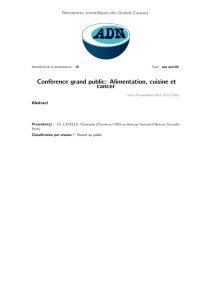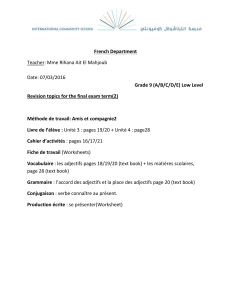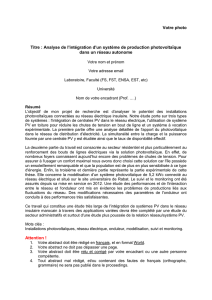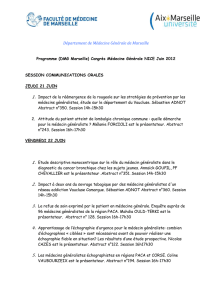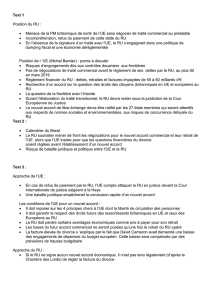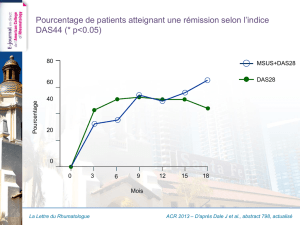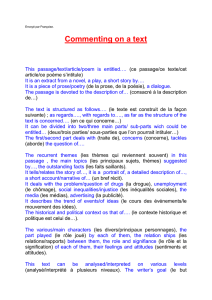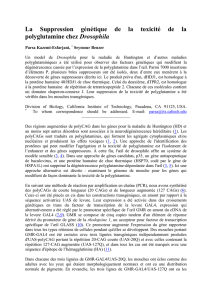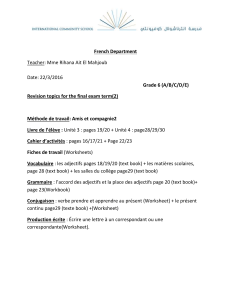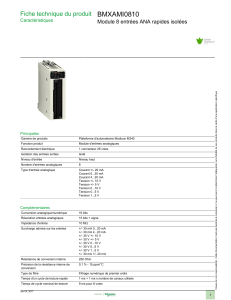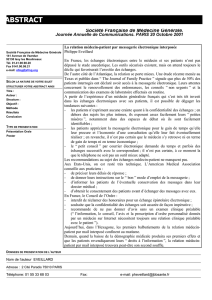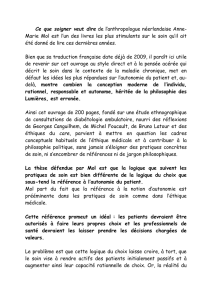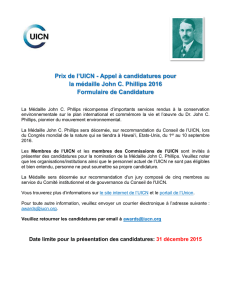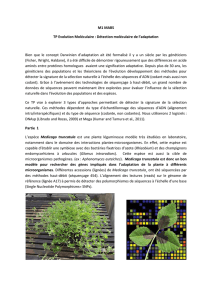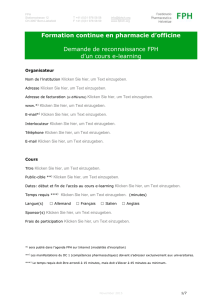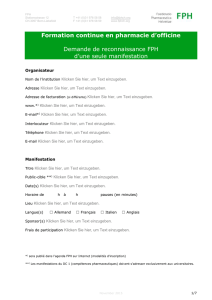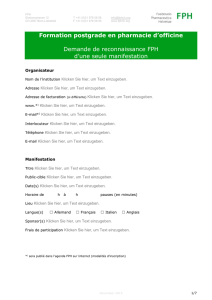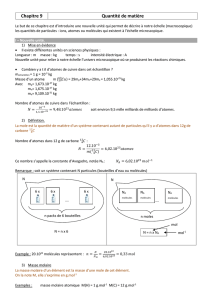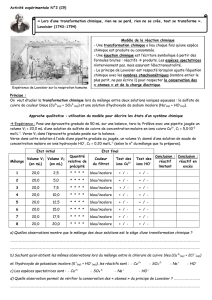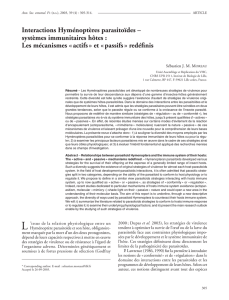La Suppression génétique de la toxicité de la polyglutamine
publicité
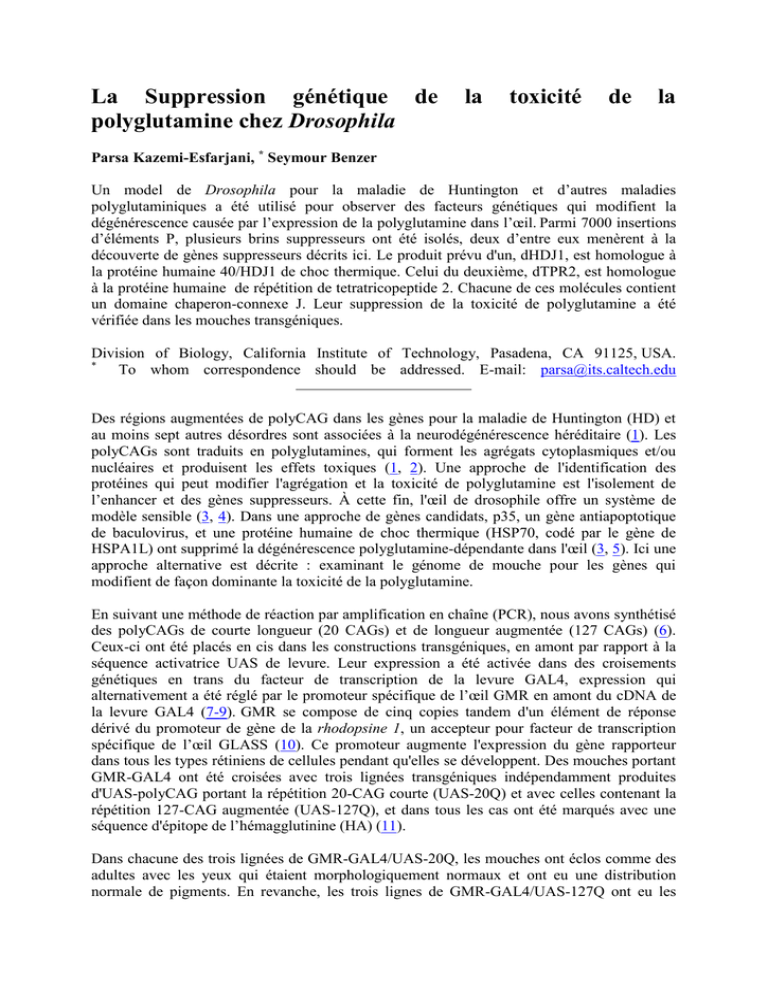
La Suppression génétique de polyglutamine chez Drosophila la toxicité de la Parsa Kazemi-Esfarjani, * Seymour Benzer Un model de Drosophila pour la maladie de Huntington et d’autres maladies polyglutaminiques a été utilisé pour observer des facteurs génétiques qui modifient la dégénérescence causée par l’expression de la polyglutamine dans l’œil. Parmi 7000 insertions d’éléments P, plusieurs brins suppresseurs ont été isolés, deux d’entre eux menèrent à la découverte de gènes suppresseurs décrits ici. Le produit prévu d'un, dHDJ1, est homologue à la protéine humaine 40/HDJ1 de choc thermique. Celui du deuxième, dTPR2, est homologue à la protéine humaine de répétition de tetratricopeptide 2. Chacune de ces molécules contient un domaine chaperon-connexe J. Leur suppression de la toxicité de polyglutamine a été vérifiée dans les mouches transgéniques. Division of Biology, California Institute of Technology, Pasadena, CA 91125, USA. * To whom correspondence should be addressed. E-mail: [email protected] Des régions augmentées de polyCAG dans les gènes pour la maladie de Huntington (HD) et au moins sept autres désordres sont associées à la neurodégénérescence héréditaire (1). Les polyCAGs sont traduits en polyglutamines, qui forment les agrégats cytoplasmiques et/ou nucléaires et produisent les effets toxiques (1, 2). Une approche de l'identification des protéines qui peut modifier l'agrégation et la toxicité de polyglutamine est l'isolement de l’enhancer et des gènes suppresseurs. À cette fin, l'œil de drosophile offre un système de modèle sensible (3, 4). Dans une approche de gènes candidats, p35, un gène antiapoptotique de baculovirus, et une protéine humaine de choc thermique (HSP70, codé par le gène de HSPA1L) ont supprimé la dégénérescence polyglutamine-dépendante dans l'œil (3, 5). Ici une approche alternative est décrite : examinant le génome de mouche pour les gènes qui modifient de façon dominante la toxicité de la polyglutamine. En suivant une méthode de réaction par amplification en chaîne (PCR), nous avons synthétisé des polyCAGs de courte longueur (20 CAGs) et de longueur augmentée (127 CAGs) (6). Ceux-ci ont été placés en cis dans les constructions transgéniques, en amont par rapport à la séquence activatrice UAS de levure. Leur expression a été activée dans des croisements génétiques en trans du facteur de transcription de la levure GAL4, expression qui alternativement a été réglé par le promoteur spécifique de l’œil GMR en amont du cDNA de la levure GAL4 (7-9). GMR se compose de cinq copies tandem d'un élément de réponse dérivé du promoteur de gène de la rhodopsine 1, un accepteur pour facteur de transcription spécifique de l’œil GLASS (10). Ce promoteur augmente l'expression du gène rapporteur dans tous les types rétiniens de cellules pendant qu'elles se développent. Des mouches portant GMR-GAL4 ont été croisées avec trois lignées transgéniques indépendamment produites d'UAS-polyCAG portant la répétition 20-CAG courte (UAS-20Q) et avec celles contenant la répétition 127-CAG augmentée (UAS-127Q), et dans tous les cas ont été marqués avec une séquence d'épitope de l’hémagglutinine (HA) (11). Dans chacune des trois lignées de GMR-GAL4/UAS-20Q, les mouches ont éclos comme des adultes avec les yeux qui étaient morphologiquement normaux et ont eu une distribution normale de pigments. En revanche, les trois lignes de GMR-GAL4/UAS-127Q ont eu les yeux sévèrement anormaux (Fig. 1). L’immunomarquage du marqueur HA de coupe histologiques au cryostat de mouches GMR-GAL4/UAS-127Q montra les agrégats dans les remnants de la rétine (12). On n'a observé aucune souillure dans les mouches GMRGAL4/UAS-20Q, probablement en raison d'un manque d'agrégation ou du renouvellement rapide de la protéine plus courte. Les mouches hétérozygotes GMR-GAL4 exprimant seulement GAL4 et chacune des trois lignées d'UAS-127Q sans GMR-GAL4 a eu une morphologie et une distribution de colorant d'œil externe et interne normale. Fig. 1. Suppression génétique de l’effet toxique de 127Q dans l’œil de mouche. SEM, microscope à scanner à électrons ; FITC, Sections gelées marquées avec un anticorps de marquage HA sur le peptide 127Q (vert) ; FITC+DAPI, double exposition DAPI pour les taches nucléaires (bleues). (A) Contrôle, expression de GAL4 régulée par GMR, l’enhancer/promoteur spécifique de l’œil, en absence de 127Q. La pigmentation rouge est due à l’expression du marqueur de gène white+ sur l’élément P GMR. Aucun agrégat n’a été observe avec FITC. DAPI montre un arrangement normal des nuclei. (B) Les mouches qui expriment le peptide 127Q conduit par GMR-GAL4. L’œil a grossièrement la taille normale, mais est sévèrement mal formé. La lumière microscopique montre l’absence de pigments. FITC montre de nombreux agrégats de polyglutamine fluorescents, la plupart localisés dans les nuclei, comme vu par recoupement avec DAPI. (C) Insertion d’élément P suppresseur EU3500 qui restore la structure externe et la pigmentation de l’œil. FITC et DAPI colorent les structures internes rétiniennes améliorées, en dépit de la présence des agrégats de polyglutamine. (D) Confirmation de la suppression dans les mouches transgéniques avec le cDNA dhdJ1, correspondant au 3' du gène de l’insertion d’élément P EU3500. Une nouvelle fois, la structure de l’œil est largement restaurée, en dépit du fait que les agrégats de polyglutamine sont toujours présents. Comme indiqué par le recoupement des colorations au DAPI et FITC, les inclusions nucléaires de polyglutamine sont présentes en périphérie de la rétine, alors que dans la rétine proximale (interne), le marquage au FITC indique seulement des inclusions cytoplasmiques. (E) Un second élément P suppresseur inséré, EU3220, améliore aussi la structure externe et la pigmentation, bien que (albeit) moins effective que EU3500. Les marquages au FITC et DAPI montrent une amélioration de la structure interne de la rétine, avec des dégénérescences rétiniennes. (F) Confirmation de la suppression dans les mouches transgéniques avec le cDNA dtrp2, correspondant au 3' du gène de l’élément P EU3220 inséré. [View Larger Version of this Image (108K GIF file)] Les mouches GMR-GAL4/UAS-127Q ont des anomalies extérieurement évidentes graves d'œil (Fig. 1) et ont été employées pour observer des modificateurs dominants de la toxicité de la répétition 127Q en examinant les gènes à proximité d'une série d'emplacements chromosomiques d'insertion de l’élément P. Ceci a été fait en les croisant avec environ 7000 brins d’insertion autosomaux de nouveau générés de l’élément (13) et en évaluant la progéniture F1 pour la suppression ou le perfectionnement du phénotype d'œil. On a établi trente lignées qui ont supprimé la dégénérescence polyglutamine-dépendante de l’œil dans des mouches hétérozygotes et 29 lignées ont été fabriquées, qui les perfectionnent (14). La délivrance de plasmide des éléments P et le flanquement d’ADN génomique a été exécutée (15), et le cDNA correspondant à l'emplacement d'insertion de l’élément P a été employé pour examiner sa capacité à supprimer la toxicité de polyglutamine. Ici nous rapportons les résultats pour les deux premières lignées pour lesquelles les effets de suppression ont été directement confirmés. Dans la première lignée, EU3500, la séquence génomique, commençant 98 paires de bases (pb) en aval de l'élément P, a atteint un tag de séquence exprimée (EST) dans la base de données du projet de génome de drosophile de Berkeley (BDGP) (15). Au moins trois clones indépendants de cDNA dans la base de données ont eu des séquences semblables mais des longueurs différentes de 3 ' UTR. Pour l'essai, GH26396 (16) a été choisi, qui est un cDNA de 1711 paires de bases qui code dHDJ1, une protéine prévue à 334 acides aminés et d’un poids moléculaire de 37kD, qui a un domaine J NH2-terminal et homologue au HSP40/HDJ1 humain (identité de 54% et similitude de 72%) (Fig. 2) (17-19). Fig. 2. Alignment of Drosophila (dHDJ1) and human HSP40 (hHsp40/HDJ1). The amino acid sequences are 54% identical and 72% similar (37). The J regions (23) are underlined. These are 74% identical and 88% similar. Light gray shading indicates similarity; dark gray shading indicates identity. [View Larger Version of this Image (48K GIF file)] Pour la deuxième lignée de suppresseur, EU3220, la séquence commençant 293 pb en aval l'élément P a atteint un EST, et le clone cDNA correspondant GH09432 (16) a été séquencé. L'insertion de l’élément P était 649 pb en 5 ' du cadre ouvert de lecture (ORF) d'un cDNA de 2239 pb, correspondant à une protéine prévue de 508 acides aminés et à un poids moléculaire de 58 kD qui contient 7 répétitions de tetratricopeptide et un domaine J COOH-terminal. Une recherche de base de données de protéine a indiqué l'homologie élevée (identité de 46% et similarité de 67%) entre ceci et la protéine humaine répétée tetratricopeptidique 2 (TPR2) (20, 21) (Fig. 3). Nous l'avons donc appelée la protéine 2 (dTPR2) de répétition de tetratricopeptide de Drosophila. Fig. 3. Alignment of Drosophila (dTPR2) and the human tetratricopeptide repeat protein 2 (hTPR2) (21). The amino acid sequences are 46% identical and 67% similar (37). The J regions (underlined) are 74% identical and 93% similar. In addition, there are seven tetratricopeptide repeat motifs, indicated by arrows. Shading is the same as in Fig. 2. [View Larger Version of this Image (77K GIF file)] Comme vu en microscopie électronique à balayage, les yeux anormaux des mouches GMRGAL4/UAS-127Q ont été spectaculairement améliorés en présence de l'insertion du suppresseur de l’élément P dans le brin EU3500 (Fig. 1C). Avec cette insertion, l'œil préserve sa structure globulaire, pigmentation, et un arrangement uniforme des poils. Bien que le résultat soit plus faible que dans EU3500, l’élément P suppresseur dans le brin EU3220 a également montré un effet spectaculaire (Fig. 1E). La structure interne de l'œil a été examinée sur des coupes horizontales de tête réalisées au cryostat. Dans les mouches non-délétées GMR-GAL4/UAS-127Q, la structure a été déformée et l’immunomarquage des peptides Ha-tagged de polyglutamine a montré de nombreux agrégats de l'isothiocyanate de fluorescéine (FITC) (Fig. 1B). En présence de l’insert du suppresseur dans le brin EU3500, la structure rétinienne a été énormément améliorée (Fig. 1C) quoique le nombre d'agrégats ait demeuré semblable. En présence d'EU3220, l'effet était similaire mais plus faible (Fig. 1E). Pour examiner si le gène immédiatement 3 ' à l'insertion EU3500 était en effet responsable de la suppression observée, le cDNA correspondant dans GH26396, qui contient les séquences codantes pour dHDJ1, a été placé dans le vecteur transgénique (22) et micro-injecté dans des embryons de mouche aux étapes précoces. Chacune des trois lignes transgéniques indépendantes, chacune portant une insertion hétérozygote autosomale d'UAS-dhdJ1 en présence de GMR-GAL4/UAS-127Q, a étroitement reproduit le phénotype de la ligne EU3500 (Fig. 1D). Ceci a confirmé que la dégénérescence polyglutamine-dépendante de l’œil par l’insertion de l’élément P et ses antagonistes transgéniques était en effet due à l’action de dHDJ1. De façon similaire, le test transgénique, qui utilisait 3 lignées transgéniques indépendantes portant une insertion UAS-dtpr2 hétérozygote avec GMR-GAL4/UAS-127Q, a confirmé que la suppression par l’élément P EU3220 et ses antagonistes transgéniques est due à l’action de dTPR2 (Fig. 1F). Les Drosophila dHDJ1 et dTPR2 ont chacune un domaine J, une portion de près de 70 acides amines trouvés dans les protéines J qui stimulent l’activité adénosine triphosphate de HSP70 (23), ce qui provoque la fermeture des sites de fixation de peptide, piégeant ainsi les substrats de protéines (24). Les protéines J lient aussi indépendamment d’autres protéines pour former des structures secondaires et tertiaires (25). L’évidence directe pour le rôle des HSPs, particulièrement les protéines J, pour empêcher l’agrégation des protéines a été apportée in vitro en montrant qu’un excès molaire de 5 plis de l’ADNJ d’Escherichia coli a complètement supprimé l’agrégation d’une protéine substrat (rhodanese mitochondriale bovine) (26). Les protéines J doivent aussi jouer un rôle dans la voie de dégradation du protéasome parce qu’un grand antigène T (Tag) du domaine J du virus simien 40 (SV40) fut requis pour la dégradation protéasome-dépendante de p130 (relatif à la protéine suppresseur de tumeur du rétinoblastome, pRB) dans la lignée cellulaire osteosarcome humaine U-2 OS (27). En effet, le domaine J de deux autres paralogues du HSP40 humain, HDJ2 (aussi connu sous le nom de DNAJ2), ou HSJ1 peut substituer le domaine J dans le Tag de SV40, et la substitution d’une glutamine pour une histidine conservée dans le domaine J pourraient avoir aboli cet effet. Le TPR2 de Drosophila peut aussi agir comme un suppresseur dans une autre voie. Les domaines TPR sont constitutes de 3 à 16 répétitions dégénérées d’une portion de 34 acides aminés, dont chacun formant une paire d’hélice α antiparallèles (28). Les unités TRP tandem multiples assemblés dans une structure super-hélicoïdale droite qui se prêtent à des interfaces protéine-protéine. Ils se trouvent dans des protéines impliquées dans des fonctions varies, incluant l’import de protéines, la neurogenèse, la réponse au stress, et l’action chaperonne (21, 29). Le TPR2 humain a été isolé d’une bibliothèque de cDNA de cellule HeLa dans un controle à double hybride, utilisant une “amorce” d’un fragment de 271 acides aminés d’un domaine relié à une protéine activatrice de guanine triphosphate (GTPase) (GRD) de neurofibromine, le produit du gène de la neurofibromatose de type 1 (NF1) (21). La neurofibromine stimule l’activité GTPase de p21 Ras et le converti à partir de la forme active (Ras-GTP) en sa forme inactive (Ras-GDP) (30). Il est concevable que la surexpression de dTPR2 dans l’œil de drosophile inhibe l’homologue de neurofibromine de Drosophila (dNF1) (31) en masquant son GRD. Ceci pourrait augmenter l’activité de Ras-GTP, qui est connu pour inhiber la protéine déficiente de l’involution de la tête proapoptotique (HID) (32) et d’augmenter la survie des cellules de l’œil. Dans les transfections de cellules en culture avec une ataxine-1 entière ou le récepteur à androgènes, chacun avec une polyglutamine étendue, co-exprimant HDJ2/HSDJ résulta en une réduction de 40 à 50% du nombre de cellules contenant des agrégats (33, 34). De façon similaire à l’effet de HSPA1L, l’EU3500 ou l’élément P EU3220 ou l’expression de leur antagoniste transgénique inhibèrent la détérioration de la structure de l’œil, mais la formation d’agrégats ne fut pas supprimée. Parce que le promoteur GMR agit précocement dans le développement de l’œil, il est possible que dHDJ1 et dTPR2 agissent à ce stade précoce de différenciation, en se liant au 127Q et en maintenant le milieu non-toxique, permettant ainsi au développement de l’œil de ce faire plus normalement. Réciproquement, ces protéines suppresseurs, plutôt que d’interagir directement avec le peptide 127Q, doivent réduire sa toxicité par un effet en aval. Les nombreux brins suppresseurs déjà en main doivent mener à la découverte d’autres gènes concernant la pathogenèse de divers désordres de polyglutamine et leur traitement prophylactique ou thérapeutique. REFERENCES AND NOTES 1. 2. 3. 4. T. W. Kim and R. E. Tanzi, Neuron 21, 657 (1998) [CrossRef] [ISI] [Medline] . Y. Trottier, et al., Nature 378, 403 (1995) [CrossRef] [Medline] . J. M. Warrick, et al., Cell 93, 939 (1998) [CrossRef] [ISI] [Medline] . G. R. Jackson, et al., Neuron 21, 633 (1998) [CrossRef] [ISI] [Medline] ; J. L. Marsh, et al., Hum. Mol. Genet. 9, 13 (2000) [Abstract/Free Full Text] . 5. J. M. Warrick, et al., Nature Genet. 23, 425 (1999) [CrossRef] [ISI] [Medline] . 6. Because it has one of the longest known CAG tracts in the fly (20 repeats), the prospero gene in the p139cAC1 plasmid (35) was used as a template for PCR synthesis of expanded polyCAG tracts. Primers used to amplify two fragments containing polyCAG tracts were as follows: (i) ProsBamHI3229F (5'-ATG CGC GGA TCC CAG CAG CTG GAG CAG AAC GAG GCC-3') with 5' phosphorylatedProsAflIIR (5'-ATT GCT GTT GCC GCC GTT CTT AAG CTG TTG TTG TTG CTG TTG TTG-3') and (ii) ProsBstBIF (5'-ACC GGA GGC CCA CCG TCA TTC GAA CAG CAG CAG CAA CAG-3') with Pros3650R (5'-GCT GCG TGC GGA TTG AAG AAC GGC-3'). These fragments were digested with Bam HI (5' fragment) or Bst XI (3' fragment) and ligated with T4 DNA ligase (Gibco/BRL) into the Bam HI-Bst XI fragment of p139cAC1. After cloning and amplifying this construct in XL1 Blue strain of E. coli (Stratagene), the sequence between the two polyCAG tracts was removed by digesting with Bst BI and Afl II (or Bfr I) and trimming the overhanging ends with mung bean nuclease (New England Biolabs), followed by ligation and transformation into XL1 Blue. To synthesize polyCAG of 127 repeats, this procedure was repeated twice more. To produce UAS-20Q and UAS-127Q, polyCAG20 and polyCAG127 and their flanking sequences were PCR-amplified by primers 5' Gln2F (5'-CGG AAT TCG CCG CCA CCA TGG GAG GCC CAC CGT CAA CCC CCC AGC AG-3') and 3' GlnR (5'-ATT GCT GTT GCC GCC GTT ACT AGT CTG TTG CTG CTG CTG TTG-3'). The PCR fragment was digested with Eco RI and Spe I and, with a Pst I-Eco RI adapter, was inserted in-frame with an HA tag DNA sequence into the Pst I-Spe I fragment of the pINDY6 transgenic vector (36). These plasmids express polyglutamine tracts flanked by 8 amino acids on the NH2-terminal side and 13 amino acids on the COOH-terminal side (MGGPPSTPQnTSRTYPYDVPDYA) (37). 7. A. H. Brand and N. Perrimon, Development 118, 401 (1993) [Abstract] . 8. M. C. Ellis, E. M. O'Neill, G. M. Rubin, Development 119, 855 (1993) [Abstract] . 9. M. Freeman, Cell 87, 651 (1996) [CrossRef] [ISI] [Medline] . 10. K. Moses and G. M. Rubin, Genes Dev. 5, 583 (1991) [Abstract/Free Full Text] . 11. Flies were maintained on a mixture of corn meal, yeast, and agar at 25°C in 70% humidity. Microinjection solutions containing the transgenic constructs were composed of the following: 13.5 µg of transgenic vector, 4.5 µg of p 25.1 transposase vector (38), 0.1 M sodium phosphate buffer (pH 7.8), and 5 mM potassium chloride, in 50 µl of aqueous solution. With Transjector 5246 and Femtotips II (Eppendorf), the transgenic constructs were microinjected into 5- to 30-min-old w1118 embryos reared at 18°C. Several transgenic lines were established for each construct. Plasmid rescue (39) and sequencing of two clones of a 127Q line, and one clone for each of the four 20Q lines, confirmed the expected polyCAG and flanking sequences in the transgenic lines. 12. Whole flies were submerged in Mirsky's fixative (National Diagnostics, Atlanta, GA) for 1 to 2 min. They were then decapitated, and the heads were placed in OCT 4583 embedding medium (Tissue-Tek, Torrance, CA), frozen on dry ice, and sectioned. Slides were dried on a 50°C hot plate for 30 s, then fixed in Mirsky's fixative for 30 min at room temperature and washed three times within 10 min with phosphate-buffered saline (PBS) and Tween 20 (PBS/Tween 20, 0.1%). The sections were blocked with 1% PBS and bovine serum albumin fraction V (Sigma), then covered with primary polyclonal antibody to HA (1 µg/ml) (Y-11; Santa Cruz Biotechnology) in the block solution for 2 hours at room temperature. They were washed three times for 5 min with PBS/Tween 20 (0.1%), covered with FITC-labeled secondary antibody to rabbit (4 µg/ml) (Jackson ImmunoResearch Laboratories) in the block solution for 1 hour at room temperature, washed for 5 min with PBS/Tween 20 (0.1%), covered with 4'-6' diamino-2-phenylindole (DAPI) (0.5 µg/ml) for 1 min, and then washed three times for 15 min with the PBS/Tween. Finally, the sections were mounted in a solution of phenylene diamine (PDA) (0.1 mg/ml), DAPI (0.5 µg/ml), and 90% glycerol and photographed on a Zeiss Axioplan fluorescent microscope. 13. This was done by de novo-generated P-element transpositions with a fly stock carrying the P[ry+, 2-3](99B) transposase (40) and an X-linked enhancer/promoter (EP) insert containing 14 UAS sequences in tandem, followed by the Hsp70 heat shock minimal promoter (pEP plasmid) (41). Transposition lines were generated by mobilizing the X-linked P element in the EP55 strain and isolating lines containing new autosomal insertions. 14. For candidate strains, the responsible chromosomes were separated from those carrying GMR-GAL4 or UAS-127Q by crossing with flies that carried the second and third balancer chromosomes CyO and TM3. Their progeny were then crossed to w1118 flies to separate the P elements, and the established strains were tested for suppression or enhancement. 15. Plasmid rescue (39) was done by purifying genomic DNA with the QIAamp Tissue kit (Qiagen, Valencia, CA) and digestion with six restriction enzymes: Bfr I, Bgl I, Eco RI, Hinc II, Sac I, and Sac II in a 100-µl reaction volume overnight. The digested fragments were purified by the QIAprep Spin Miniprep kit (Qiagen), circularized by ligation in a 50-µl reaction volume, and transformed by electroporation of 1.5 µl of ligation reaction into the DH10B strain of E. coli (Gibco/BRL). Bacteria were plated on agar and kanamycin (10 µg/ml). Inserts were sequenced and sequence comparison was done with the BLAST server at BDGP. The protein alignments were done with MacVector 6.0 software. 16. The clone was purchased from Research Genetics, Huntsville, AL. 17. The GenBank accession number is U34904. For consistency, we have changed the original name, DROJ1 (for Drosophila melanogaster DnaJ homolog) to dHDJ1 (for Drosophila homolog of HDJ1). 18. T. Raabe and J. L. Manley, Nucleic Acids Res. 19, 6645 (1991) [Free Full Text] . 19. M. Hata, K. Okumura, M. Seto, K. Ohtsuka, Genomics 38, 446 (1996) [CrossRef] [ISI] [Medline] . 20. The GenBank accession number is AF199022. 21. A. E. Murthy, A. Bernards, D. Church, J. Wasmuth, J. F. Gusella, DNA and Cell Biology 15, 727 (1996) [ISI] [Medline] . 22. The Pst I-Xho I fragment contained a 106-bp Pst I-Eco RI fragment of pOT2a, 11 bp upstream of the reported 5' UTR; the 5' UTR; the 1005-bp dhdJ1 ORF; 406 bp of the 579-bp reported 3' UTR; and a 23-bp-long polyadenlyate. It was removed from GH26396, contained in the plasmid pOT2a (Research Genetics), and ligated into the transgenic vector pINDY6 Pst I-Xho I site. For cloning dtpr2, the Pst I-Xho I fragment, containing a 106-bp Pst I-Eco RI fragment of pOT2a, the 365-bp 5' UTR, the 1527-bp dtpr2 ORF, the 328-bp 3' UTR, and a 20-bp-long polyadenlyate was removed from GH09432 (within pOT2a) and ligated into the transgenic vector pINDY6 Pst I-Xho I site. 23. W. L. Kelley, Trends Biochem. Sci. 23, 222 (1998) [CrossRef] [ISI] [Medline] . 24. B. Misselwitz, O. Staeck, T. A. Rapoport, Mol. Cell 2, 593 (1998) [CrossRef] [ISI] [Medline] . 25. D. M. Cyr, T. Langer, M. G. Douglas, Trends Biochem. Sci. 19, 176 (1994) [CrossRef] [ISI] [Medline] . 26. T. Langer, et al., Nature 356, 683 (1992) [CrossRef] [Medline] . 27. H. Stubdal, et al., Mol. Cell. Biol. 17, 4979 (1997) [Abstract] . 28. M. R. Groves and D. Barford, Curr. Opin. Struct. Biol. 9, 383 (1999) [CrossRef] [ISI] [Medline] . 29. J. R. Lamb, S. Tugendreich, P. Hieter, Trends Biochem. Sci. 20, 257 (1995) [CrossRef] [ISI] [Medline] . 30. B. Weiss, G. Bollag, K. Shannon, Am. J. Med. Genet. 89, 14 (1999) [ISI] [Medline] . 31. I. The, et al., Science 276, 791 (1997) [Abstract/Free Full Text] . 32. A. Bergmann, J. Agapite, K. McCall, H. Steller, Cell 95, 331 (1998) [CrossRef] [ISI] [Medline] . 33. C. J. Cummings, et al., Nature Genet. 19, 148 (1998) [CrossRef] [ISI] [Medline] . 34. D. L. Stenoien, et al., Hum. Mol. Genet. 8, 731 (1999) [Abstract/Free Full Text] . 35. C. Q. Doe, Q. Chu-LaGraff, D. M. Wright, M. P. Scott, Cell 65, 451 (1991) [CrossRef] [ISI] [Medline] . 36. L. Seroude and S. Benzer, unpublished material. 37. Single-letter abbreviations for the amino acid residues are as follows: A, Ala; C, Cys; D, Asp; E, Glu; F, Phe; G, Gly; H, His; I, Ile; K, Lys; L, Leu; M, Met; N, Asn; P, Pro; Q, Gln; R, Arg; S, Ser; T, Thr; V, Val; W, Trp; and Y, Tyr. 38. A. C. Spradling and G. M. Rubin, Science 218, 341 (1982) [Abstract/Free Full Text] . 39. V. Pirrotta, Cloning Drosophila Genes: A Practical Approach, D. B. Roberts, Ed. (IRL, Oxford, Washington DC, 1986), pp. 83-110. 40. H. M. Robertson, et al., Genetics 118, 461 (1988) [Abstract/Free Full Text] . 41. P. Rorth, Proc. Natl. Acad. Sci. U.S.A. 93, 12418 (1996) [Abstract/Free Full Text] . 42. We thank C. Q. Doe for the gift of prospero cDNA clone p139cAC1; L. Seroude for the transgenic vector; and V. Sapin, R. Young, and A. Gomez for invaluable technical support. Supported by a Cure HD Initiative postdoctoral fellowship from the Hereditary Disease Foundation and a grant from the Wills Foundation to P.K.-E. and by grants to S.B. from NSF, NIH, and the James G. Boswell Foundation. 2 November 1999; accepted 24 January 2000 THIS ARTICLE HAS BEEN CITED BY OTHER ARTICLES: AKT-sensitive or insensitive pathways of toxicity in glial cells and neurons in Drosophila models of Huntington's disease. J.-C. Lievens, M. Iche, M. Laval, C. Faivre-Sarrailh, and S. Birman (2008) Hum. Mol. Genet. 17, 882-894 | Abstract » | Full Text » | PDF » Suppression of in Vivo -Amyloid Peptide Toxicity by Overexpression of the HSP-16.2 Small Chaperone Protein. V. Fonte, D. R. Kipp, J. Yerg III, D. Merin, M. Forrestal, E. Wagner, C. M. Roberts, and C. D. Link (2008) J. Biol. Chem. 283, 784-791 | Abstract » | Full Text » | PDF » Protein interactions and disease: computational approaches to uncover the etiology of diseases. M. G. Kann (2007) Brief Bioinform 8, 333-346 | Abstract » | Full Text » | PDF » Intersectin enhances huntingtin aggregation and neurodegeneration through activation of cJun-NH2-terminal kinase. E. Scappini, T.-W. Koh, N. P. Martin, and J. P. O'Bryan (2007) Hum. Mol. Genet. 16, 1862-1871 | Abstract » | Full Text » | PDF » Demyelination, Astrogliosis, and Accumulation of Ubiquitinated Proteins, Hallmarks of CNS Disease in hsf1-Deficient Mice. S. Homma, X. Jin, G. Wang, N. Tu, J. Min, N. Yanasak, and N. F. Mivechi (2007) J. Neurosci. 27, 7974-7986 | Abstract » | Full Text » | PDF » Genetic Modifiers of the Drosophila Blue Cheese Gene Link Defects in Lysosomal Transport With Decreased Life Span and Altered Ubiquitinated-Protein Profiles. A. Simonsen, R. C. Cumming, K. Lindmo, V. Galaviz, S. Cheng, T. E. Rusten, and K. D. Finley (2007) Genetics 176, 1283-1297 | Abstract » | Full Text » | PDF » A Conditional Pan-Neuronal Drosophila Model of Spinocerebellar Ataxia 7 with a Reversible Adult Phenotype Suitable for Identifying Modifier Genes. M. Latouche, C. Lasbleiz, E. Martin, V. Monnier, T. Debeir, A. Mouatt-Prigent, M.-P. Muriel, L. Morel, M. Ruberg, A. Brice, et al. (2007) J. Neurosci. 27, 2483-2492 | Abstract » | Full Text » | PDF » Cytoskeleton proteins are modulators of mutant tau-induced neurodegeneration in Drosophila. O. Blard, S. Feuillette, J. Bou, B. Chaumette, T. Frebourg, D. Campion, and M. Lecourtois (2007) Hum. Mol. Genet. 16, 555-566 | Abstract » | Full Text » | PDF » Differential Effects of Mitochondrial Heat Shock Protein 60 and Related Molecular Chaperones to Prevent Intracellular beta-Amyloid-induced Inhibition of Complex IV and Limit Apoptosis. V. Veereshwarayya, P. Kumar, K. M. Rosen, R. Mestril, and H. W. Querfurth (2006) J. Biol. Chem. 281, 29468-29478 | Abstract » | Full Text » | PDF » CHIP Protects from the Neurotoxicity of Expanded and Wild-type Ataxin-1 and Promotes Their Ubiquitination and Degradation. I. Al-Ramahi, Y. C. Lam, H.-K. Chen, B. de Gouyon, M. Zhang, A. M. Perez, J. Branco, M. de Haro, C. Patterson, H. Y. Zoghbi, et al. (2006) J. Biol. Chem. 281, 26714-26724 | Abstract » | Full Text » | PDF » Molecular pathways that influence human tau-induced pathology in Caenorhabditis elegans. B. C. Kraemer, J. K. Burgess, J. H. Chen, J. H. Thomas, and G. D. Schellenberg (2006) Hum. Mol. Genet. 15, 1483-1496 | Abstract » | Full Text » | PDF » Rapamycin alleviates toxicity of different aggregate-prone proteins. Z. Berger, B. Ravikumar, F. M. Menzies, L. G. Oroz, B. R. Underwood, M. N. Pangalos, I. Schmitt, U. Wullner, B. O. Evert, C. J. O'Kane, et al. (2006) Hum. Mol. Genet. 15, 433-442 | Abstract » | Full Text » | PDF » Human Expanded Polyglutamine Androgen Receptor Mutants in Neurodegeneration as a Novel Ligand Target. T. Furutani, K.-i. Takeyama, M. Tanabe, H. Koutoku, S. Ito, N. Taniguchi, E. Suzuki, M. Kudoh, M. Shibasaki, H. Shikama, et al. (2005) J. Pharmacol. Exp. Ther. 315, 545-552 | Abstract » | Full Text » | PDF » Lithium rescues toxicity of aggregate-prone proteins in Drosophila by perturbing Wnt pathway. Z. Berger, E. K. Ttofi, C. H. Michel, M. Y. Pasco, S. Tenant, D. C. Rubinsztein, and C. J. O'Kane (2005) Hum. Mol. Genet. 14, 3003-3011 | Abstract » | Full Text » | PDF » Active HSF1 Significantly Suppresses Polyglutamine Aggregate Formation in Cellular and Mouse Models. M. Fujimoto, E. Takaki, T. Hayashi, Y. Kitaura, Y. Tanaka, S. Inouye, and A. Nakai (2005) J. Biol. Chem. 280, 34908-34916 | Abstract » | Full Text » | PDF » CHIP Suppresses Polyglutamine Aggregation and Toxicity In Vitro and In Vivo. V. M. Miller, R. F. Nelson, C. M. Gouvion, A. Williams, E. Rodriguez-Lebron, S. Q. Harper, B. L. Davidson, M. R. Rebagliati, and H. L. Paulson (2005) J. Neurosci. 25, 9152-9161 | Abstract » | Full Text » | PDF » Drosophila: A "Model" Model System To Study Neurodegeneration. A. M. Celotto and M. J. Palladino (2005) Mol. Interv. 5, 292-303 | Abstract » | Full Text » | PDF » Suppression of Huntington's disease pathology in Drosophila by human single-chain Fv antibodies. W. J. Wolfgang, T. W. Miller, J. M. Webster, J. S. Huston, L. M. Thompson, J. L. Marsh, and A. Messer (2005) PNAS 102, 11563-11568 | Abstract » | Full Text » | PDF » cAMP-response element-binding protein and heat-shock protein 70 additively suppress polyglutamine-mediated toxicity in Drosophila. K. Iijima-Ando, P. Wu, E. A. Drier, K. Iijima, and J. C. P. Yin (2005) PNAS 102, 10261-10266 | Abstract » | Full Text » | PDF » Chaperone proteins and brain tumors: Potential targets and possible therapeutics. M. W. Graner and D. D. Bigner (2005) Neuro-oncol 7, 260-278 | Abstract » | PDF » Modulation of Prion-dependent Polyglutamine Aggregation and Toxicity by Chaperone Proteins in the Yeast Model. K. C. Gokhale, G. P. Newnam, M. Y. Sherman, and Y. O. Chernoff (2005) J. Biol. Chem. 280, 22809-22818 | Abstract » | Full Text » | PDF » Cardiac Systems Biology. A. D. MCCULLOCH and G. PATERNOSTRO (2005) Ann. N.Y. Acad. Sci. 1047, 283-295 | Abstract » | Full Text » | PDF » The pathogenic agent in Drosophila models of 'polyglutamine' diseases. C. J. McLeod, L. V. O'Keefe, and R. I. Richards (2005) Hum. Mol. Genet. 14, 1041-1048 | Abstract » | Full Text » | PDF » Hsp70 and Hsp40 Chaperones Do Not Modulate Retinal Phenotype in SCA7 Mice. D. Helmlinger, J. Bonnet, J.-L. Mandel, Y. Trottier, and D. Devys (2004) J. Biol. Chem. 279, 55969-55977 | Abstract » | Full Text » | PDF » Trinucleotide repeats and neurodegenerative disease. C. M. Everett and N. W. Wood (2004) Brain 127, 2385-2405 | Abstract » | Full Text » | PDF » Comparison of pathways controlling toxicity in the eye and brain in Drosophila models of human neurodegenerative diseases. S. Ghosh and M. B. Feany (2004) Hum. Mol. Genet. 13, 2011-2018 | Abstract » | Full Text » | PDF » Multiple-stress analysis for isolation of Drosophila longevity genes. H.-D. Wang, P. Kazemi-Esfarjani, and S. Benzer (2004) PNAS 101, 12610-12615 | Abstract » | Full Text » | PDF » Progressive decrease in chaperone protein levels in a mouse model of Huntington's disease and induction of stress proteins as a therapeutic approach. D. G. Hay, K. Sathasivam, S. Tobaben, B. Stahl, M. Marber, R. Mestril, A. Mahal, D. L. Smith, B. Woodman, and G. P. Bates (2004) Hum. Mol. Genet. 13, 1389-1405 | Abstract » | Full Text » | PDF » From The Cover: Genome-wide RNA interference screen identifies previously undescribed regulators of polyglutamine aggregation. E. A. A. Nollen, S. M. Garcia, G. van Haaften, S. Kim, A. Chavez, R. I. Morimoto, and R. H. A. Plasterk (2004) PNAS 101, 6403-6408 | Abstract » | Full Text » | PDF » Ataxin 1, a SCA1 neurodegenerative disorder protein, is functionally linked to the silencing mediator of retinoid and thyroid hormone receptors. C.-C. Tsai, H.-Y. Kao, A. Mitzutani, E. Banayo, H. Rajan, M. McKeown, and R. M. Evans (2004) PNAS 101, 4047-4052 | Abstract » | Full Text » | PDF » Cytoplasmic aggregates trap polyglutamine-containing proteins and block axonal transport in a Drosophila model of Huntington's disease. W.-C. M. Lee, M. Yoshihara, and J. T. Littleton (2004) PNAS 101, 3224-3229 | Abstract » | Full Text » | PDF » Heat Shock Protein 70 Participates in the Neuroprotective Response to Intracellularly Expressed {beta}-Amyloid in Neurons. J. Magrane, R. C. Smith, K. Walsh, and H. W. Querfurth (2004) J. Neurosci. 24, 1700-1706 | Abstract » | Full Text » | PDF » Yeast Genes That Enhance the Toxicity of a Mutant Huntingtin Fragment or {alpha}Synuclein. S. Willingham, T. F. Outeiro, M. J. DeVit, S. L. Lindquist, and P. J. Muchowski (2003) Science 302, 1769-1772 | Abstract » | Full Text » | PDF » Crystal Structures of Human DJ-1 and Escherichia coli Hsp31, Which Share an Evolutionarily Conserved Domain. S.-J. Lee, S. J. Kim, I.-K. Kim, J. Ko, C.-S. Jeong, G.-H. Kim, C. Park, S.-O. Kang, P.-G. Suh, H.-S. Lee, et al. (2003) J. Biol. Chem. 278, 44552-44559 | Abstract » | Full Text » | PDF » Cytoplasmic Accumulation of the Nuclear Receptor CAR by a Tetratricopeptide Repeat Protein in HepG2 Cells. K. Kobayashi, T. Sueyoshi, K. Inoue, R. Moore, and M. Negishi (2003) Mol. Pharmacol. 64, 1069-1075 | Abstract » | Full Text » | PDF » Genetic Modifiers of Tauopathy in Drosophila. J. M. Shulman and M. B. Feany (2003) Genetics 165, 1233-1242 | Abstract » | Full Text » | PDF » Involvement of the ubiquitin-proteasome pathway and molecular chaperones in oculopharyngeal muscular dystrophy. A. Abu-Baker, C. Messaed, J. Laganiere, C. Gaspar, B. Brais, and G. A. Rouleau (2003) Hum. Mol. Genet. 12, 2609-2623 | Abstract » | Full Text » | PDF » Pathogenesis of polyglutamine disorders: aggregation revisited. A. Michalik and C. Van Broeckhoven (2003) Hum. Mol. Genet. 12, R173-186 | Abstract » | Full Text » | PDF » Fly models of Huntington's disease. J. L. Marsh, J. Pallos, and L. M. Thompson (2003) Hum. Mol. Genet. 12, R187-193 | Abstract » | Full Text » | PDF » Integrative Physiology and Functional Genomics of Epithelial Function in a Genetic Model Organism. J. A. T. DOW and S. A. DAVIES (2003) Physiol Rev 83, 687-729 | Abstract » | Full Text » | PDF » Hsp105{alpha} Suppresses the Aggregation of Truncated Androgen Receptor with Expanded CAG Repeats and Cell Toxicity. K. Ishihara, N. Yamagishi, Y. Saito, H. Adachi, Y. Kobayashi, G. Sobue, K. Ohtsuka, and T. Hatayama (2003) J. Biol. Chem. 278, 25143-25150 | Abstract » | Full Text » | PDF » Polyglutamine protein aggregation and toxicity are linked to the cellular stress response. K.J. Cowan, M.I. Diamond, and W.J. Welch (2003) Hum. Mol. Genet. 12, 1377-1391 | Abstract » | Full Text » | PDF » Aberrant histone acetylation, altered transcription, and retinal degeneration in a Drosophila model of polyglutamine disease are rescued by CREB-binding protein. J. P. Taylor, A. A. Taye, C. Campbell, P. Kazemi-Esfarjani, K. H. Fischbeck, and K.T. Min (2003) Genes & Dev. 17, 1463-1468 | Abstract » | Full Text » | PDF » Yeast, Flies, Worms, and Fish in the Study of Human Disease. I. K. Hariharan and D. A. Haber (2003) N. Engl. J. Med. 348, 2457-2463 | Full Text » | PDF » Parkin Facilitates the Elimination of Expanded Polyglutamine Proteins and Leads to Preservation of Proteasome Function. Y. C. Tsai, P. S. Fishman, N. V. Thakor, and G. A. Oyler (2003) J. Biol. Chem. 278, 22044-22055 | Abstract » | Full Text » | PDF » Prevention of polyglutamine oligomerization and neurodegeneration by the peptide inhibitor QBP1 in Drosophila. Y. Nagai, N. Fujikake, K. Ohno, H. Higashiyama, H. A. Popiel, J. Rahadian, M. Yamaguchi, W. J. Strittmatter, J. R. Burke, and T. Toda (2003) Hum. Mol. Genet. 12, 1253-1259 | Abstract » | Full Text » | PDF » A cell-based assay for aggregation inhibitors as therapeutics of polyglutamine-repeat disease and validation in Drosophila. B. L. Apostol, A. Kazantsev, S. Raffioni, K. Illes, J. Pallos, L. Bodai, N. Slepko, J. E. Bear, F. B. Gertler, S. Hersch, et al. (2003) PNAS 100, 5950-5955 | Abstract » | Full Text » | PDF » blue cheese Mutations Define a Novel, Conserved Gene Involved in Progressive Neural Degeneration. K. D. Finley, P. T. Edeen, R. C. Cumming, M. D. Mardahl-Dumesnil, B. J. Taylor, M. H. Rodriguez, C. E. Hwang, M. Benedetti, and M. McKeown (2003) J. Neurosci. 23, 1254-1264 | Abstract » | Full Text » | PDF » Suppression of polyglutamine-induced protein aggregation in Caenorhabditis elegans by torsin proteins. G. A. Caldwell, S. Cao, E. G. Sexton, C. C. Gelwix, J. P. Bevel, and K. A. Caldwell (2003) Hum. Mol. Genet. 12, 307-319 | Abstract » | Full Text » | PDF » Glutamine/proline-rich PQE-1 proteins protect Caenorhabditis elegans neurons from huntingtin polyglutamine neurotoxicity. P. W. Faber, C. Voisine, D. C. King, E. A. Bates, and A. C. Hart (2002) PNAS 99, 17131-17136 | Abstract » | Full Text » | PDF » Golgi Fragmentation Occurs in the Cells with Prefibrillar alpha -Synuclein Aggregates and Precedes the Formation of Fibrillar Inclusion. N. Gosavi, H.-J. Lee, J. S. Lee, S. Patel, and S.-J. Lee (2002) J. Biol. Chem. 277, 48984-48992 | Abstract » | Full Text » | PDF » Essential Role for the SMN Complex in the Specificity of snRNP Assembly. L. Pellizzoni, J. Yong, and G. Dreyfuss (2002) Science 298, 1775-1779 | Abstract » | Full Text » | PDF » Genetic modulation of polyglutamine toxicity by protein conjugation pathways in Drosophila. H.Y. E. Chan, J. M. Warrick, I. Andriola, D. Merry, and N. M. Bonini (2002) Hum. Mol. Genet. 11, 2895-2904 | Abstract » | Full Text » | PDF » Aggregated polyglutamine peptides delivered to nuclei are toxic to mammalian cells. W. Yang, J. R. Dunlap, R. B. Andrews, and R. Wetzel (2002) Hum. Mol. Genet. 11, 2905-2917 | Abstract » | Full Text » | PDF » Suppression of polyglutamine toxicity by a Drosophila homolog of myeloid leukemia factor 1. P. Kazemi-Esfarjani and S. Benzer (2002) Hum. Mol. Genet. 11, 2657-2672 | Abstract » | Full Text » | PDF » Huntington's disease age-of-onset linked to polyglutamine aggregation nucleation. S. Chen, F. A. Ferrone, and R. Wetzel (2002) PNAS 99, 11884-11889 | Abstract » | Full Text » | PDF » A mouse model of spinal and bulbar muscular atrophy. P. McManamny, H. S. Chy, D. I. Finkelstein, R. G. Craythorn, P. J. Crack, I. Kola, S. S. Cheema, M. K. Horne, N. G. Wreford, M. K. O'Bryan, et al. (2002) Hum. Mol. Genet. 11, 2103-2111 | Abstract » | Full Text » | PDF » Altered transcriptional regulation in cells expressing the expanded polyglutamine androgen receptor. A. P. Lieberman, G. Harmison, A. D. Strand, J. M. Olson, and K. H. Fischbeck (2002) Hum. Mol. Genet. 11, 1967-1976 | Abstract » | Full Text » | PDF » Live-cell imaging reveals divergent intracellular dynamics of polyglutamine disease proteins and supports a sequestration model of pathogenesis. Y. Chai, J. Shao, V. M. Miller, A. Williams, and H. L. Paulson (2002) PNAS 99, 9310-9315 | Abstract » | Full Text » | PDF » Temperature-Sensitive Paralytic Mutants Are Enriched For Those Causing Neurodegeneration in Drosophila. M. J. Palladino, T. J. Hadley, and B. Ganetzky (2002) Genetics 161, 1197-1208 | Abstract » | Full Text » | PDF » Huntingtin toxicity in yeast model depends on polyglutamine aggregation mediated by a prion-like protein Rnq1. A. B. Meriin, X. Zhang, X. He, G. P. Newnam, Y. O. Chernoff, and M. Y. Sherman (2002) J. Cell Biol. 157, 997-1004 | Abstract » | Full Text » | PDF » Transmission of proteotoxicity across cellular compartments. T. Yoneda, F. Urano, and D. Ron (2002) Genes & Dev. 16, 1307-1313 | Full Text » | PDF » ASK1 is essential for endoplasmic reticulum stress-induced neuronal cell death triggered by expanded polyglutamine repeats. H. Nishitoh, A. Matsuzawa, K. Tobiume, K. Saegusa, K. Takeda, K. Inoue, S. Hori, A. Kakizuka, and H. Ichijo (2002) Genes & Dev. 16, 1345-1355 | Abstract » | Full Text » | PDF » Characterization of a Brain-enriched Chaperone, MRJ, That Inhibits Huntingtin Aggregation and Toxicity Independently. J.-Z. Chuang, H. Zhou, M. Zhu, S.-H. Li, X.-J. Li, and C.-H. Sung (2002) J. Biol. Chem. 277, 19831-19838 | Abstract » | Full Text » | PDF » Heat shock protein 27 prevents cellular polyglutamine toxicity and suppresses the increase of reactive oxygen species caused by huntingtin. A. Wyttenbach, O. Sauvageot, J. Carmichael, C. Diaz-Latoud, A.-P. Arrigo, and D. C. Rubinsztein (2002) Hum. Mol. Genet. 11, 1137-1151 | Abstract » | Full Text » | PDF » Huntingtin inclusions do not deplete polyglutamine-containing transcription factors in HD mice. Z.-X. Yu, S.-H. Li, H.-P. Nguyen, and X.-J. Li (2002) Hum. Mol. Genet. 11, 905-914 | Abstract » | Full Text » | PDF » Molecular Chaperones in the Cytosol: from Nascent Chain to Folded Protein. F. U. Hartl and M. Hayer-Hartl (2002) Science 295, 1852-1858 | Abstract » | Full Text » | PDF » Molecular chaperones enhance the degradation of expanded polyglutamine repeat androgen receptor in a cellular model of spinal and bulbar muscular atrophy. C. K. Bailey, I. F. M. Andriola, H. H. Kampinga, and D. E. Merry (2002) Hum. Mol. Genet. 11, 515-523 | Abstract » | Full Text » | PDF » Alpha1-Antitrypsin Deficiency -- A Model for Conformational Diseases. R. W. Carrell and D. A. Lomas (2002) N. Engl. J. Med. 346, 45-53 | Full Text » | PDF » Rescue of polyglutamine-mediated cytotoxicity by double-stranded RNA-mediated RNA interference. N. J. Caplen, J. P. Taylor, V. S. Statham, F. Tanaka, A. Fire, and R. A. Morgan (2002) Hum. Mol. Genet. 11, 175-184 | Abstract » | Full Text » | PDF » Chaperone Suppression of Cellular Toxicity of Huntingtin Is Independent of Polyglutamine Aggregation. H. Zhou, S.-H. Li, and X.-J. Li (2001) J. Biol. Chem. 276, 48417-48424 | Abstract » | Full Text » | PDF » Glucocorticoid modulation of androgen receptor nuclear aggregation and cellular toxicity is associated with distinct forms of soluble expanded polyglutamine protein. W. J. Welch and M. I. Diamond (2001) Hum. Mol. Genet. 10, 3063-3074 | Abstract » | Full Text » | PDF » Huntingtin Aggregate-Associated Axonal Degeneration is an Early Pathological Event in Huntington's Disease Mice. H. Li, S.-H. Li, Z.-X. Yu, P. Shelbourne, and X.-J. Li (2001) J. Neurosci. 21, 8473-8481 | Abstract » | Full Text » | PDF » Sequence Analysis of the Human Genome: Implications for the Understanding of Nervous System Function and Disease. A. Cravchik, G. Subramanian, S. Broder, and J. C. Venter (2001) Arch Neurol 58, 1772-1778 | Abstract » | Full Text » | PDF » Altered transcription in yeast expressing expanded polyglutamine. R. E. Hughes, R. S. Lo, C. Davis, A. D. Strand, C. L. Neal, J. M. Olson, and S. Fields (2001) PNAS | Abstract » | Full Text » | PDF » Expanded polyglutamines in Caenorhabditis elegans cause axonal abnormalities and severe dysfunction of PLM mechanosensory neurons without cell death. J. A. Parker, J. B. Connolly, C. Wellington, M. Hayden, J. Dausset, and C. Neri (2001) PNAS | Abstract » | Full Text » | PDF » SCA1 molecular genetics: a history of a 13 year collaboration against glutamines. H. T. Orr and H. Y. Zoghbi (2001) Hum. Mol. Genet. 10, 2307-2311 | Abstract » | Full Text » | PDF » Mechanism of Prion Loss after Hsp104 Inactivation in Yeast. R. D. Wegrzyn, K. Bapat, G. P. Newnam, A. D. Zink, and Y. O. Chernoff (2001) Mol. Cell. Biol. 21, 4656-4669 | Abstract » | Full Text » | PDF » Over-expression of inducible HSP70 chaperone suppresses neuropathology and improves motor function in SCA1 mice. C. J. Cummings, Y. Sun, P. Opal, B. Antalffy, R. Mestril, H. T. Orr, W. H. Dillmann, and H. Y. Zoghbi (2001) Hum. Mol. Genet. 10, 1511-1518 | Abstract » | Full Text » | PDF » Intracellular Aggregation of Polypeptides with Expanded Polyglutamine Domain Is Stimulated by Stress-activated Kinase MEKK1. A. B. Meriin, K. Mabuchi, V. L. Gabai, J. A. Yaglom, A. Kazantsev, and M. Y. Sherman (2001) J. Cell Biol. 153, 851-864 | Abstract » | Full Text » | PDF » Beyond the Qs in the polyglutamine diseases. H. T. Orr (2001) Genes & Dev. 15, 925-932 | Full Text » The Gln-Ala repeat transcriptional activator CA150 interacts with huntingtin: Neuropathologic and genetic evidence for a role in Huntington's disease pathogenesis. S. Holbert, I. Denghien, T. Kiechle, A. Rosenblatt, C. Wellington, M. R. Hayden, R. L. Margolis, C. A. Ross, J. Dausset, R. J. Ferrante, et al. (2001) PNAS | Abstract » | Full Text » Mechanisms of chaperone suppression of polyglutamine disease: selectivity, synergy and modulation of protein solubility in Drosophila. H.Y. E. Chan, J. M. Warrick, G. L. Gray-Board, H. L. Paulson, and N. M. Bonini (2000) Hum. Mol. Genet. 9, 2811-2820 | Abstract » | Full Text » | PDF » Polyglutamine disease and neuronal cell death. H. L. Paulson, N. M. Bonini, and K. A. Roth (2000) PNAS | Full Text » Expanded polyglutamines induce neurodegeneration and trans-neuronal alterations in cerebellum and retina of SCA7 transgenic mice. G. Yvert, K. S. Lindenberg, S. Picaud, G. B. Landwehrmeyer, J.-A. Sahel, and J.-L. Mandel (2000) Hum. Mol. Genet. 9, 2491-2506 | Abstract » | Full Text » | PDF » A Survey of Human Disease Gene Counterparts in the Drosophila Genome. M. E. Fortini, M. P. Skupski, M. S. Boguski, and I. K. Hariharan (2000) J. Cell Biol. 150, F23-F30 | Abstract » | Full Text » | PDF » Hsp70 and Hsp40 chaperones can inhibit self-assembly of polyglutamine proteins into amyloid-like fibrils. P. J. Muchowski, G. Schaffar, A. Sittler, E. E. Wanker, M. K. Hayer-Hartl, and F. U. Hartl (2000) PNAS | Abstract » | Full Text » Involvement of T-complex Protein-1delta in Dopamine Triggered Apoptosis in Chick Embryo Sympathetic Neurons. R. Zilkha-Falb, A. Barzilai, R. Djaldeti, I. Ziv, E. Melamed, and A. Shirvan (2000) J. Biol. Chem. 275, 36380-36387 | Abstract » | Full Text » | PDF » Requirement of an intact microtubule cytoskeleton for aggregation and inclusion body formation by a mutant huntingtin fragment. P. J. Muchowski, K. Ning, C. D'Souza-Schorey, and S. Fields (2002) PNAS 99, 727-732 | Abstract » | Full Text » | PDF » The Gln-Ala repeat transcriptional activator CA150 interacts with huntingtin: Neuropathologic and genetic evidence for a role in Huntington's disease pathogenesis. S. Holbert, I. Denghien, T. Kiechle, A. Rosenblatt, C. Wellington, M. R. Hayden, R. L. Margolis, C. A. Ross, J. Dausset, R. J. Ferrante, et al. (2001) PNAS 98, 1811-1816 | Abstract » | Full Text » | PDF » Polyglutamine aggregates alter protein folding homeostasis in Caenorhabditis elegans. S. H. Satyal, E. Schmidt, K. Kitagawa, N. Sondheimer, S. Lindquist, J. M. Kramer, and R. I. Morimoto (2000) PNAS 97, 5750-5755 | Abstract » | Full Text » | PDF » Hsp70 and Hsp40 chaperones can inhibit self-assembly of polyglutamine proteins into amyloid-like fibrils. P. J. Muchowski, G. Schaffar, A. Sittler, E. E. Wanker, M. K. Hayer-Hartl, and F. U. Hartl (2000) PNAS 97, 7841-7846 | Abstract » | Full Text » | PDF » Altered transcription in yeast expressing expanded polyglutamine. R. E. Hughes, R. S. Lo, C. Davis, A. D. Strand, C. L. Neal, J. M. Olson, and S. Fields (2001) PNAS 98, 13201-13206 | Abstract » | Full Text » | PDF » Polyglutamine disease and neuronal cell death. H. L. Paulson, N. M. Bonini, and K. A. Roth (2000) PNAS 97, 12957-12958 | Full Text » | PDF » Expanded polyglutamines in Caenorhabditis elegans cause axonal abnormalities and severe dysfunction of PLM mechanosensory neurons without cell death. J. A. Parker, J. B. Connolly, C. Wellington, M. Hayden, J. Dausset, and C. Neri (2001) PNAS 98, 13318-13323 | Abstract » | Full Text » | PDF » Age-Associated Cardiac Dysfunction in Drosophila melanogaster. G. Paternostro, C. Vignola, D.-U. Bartsch, J. H. Omens, A. D. McCulloch, and J. C. Reed (2001) Circ. Res. 88, 1053-1058 | Abstract » | Full Text »
